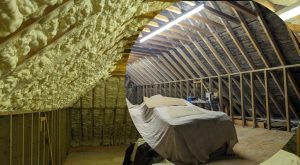Recent media and industry reports indicate that some homeowners are struggling to re-mortgage or sell properties with spray foam insulation.
Incorrect installation can result in condensation, potentially damaging the roof structure.
This article focuses on England.
What is Spray Foam Insulation?
This type of insulation is a method used to insulate homes, preventing heat loss, enhancing energy efficiency, and reducing energy bills.
It is applied as a liquid using a spray gun, which then expands to fill the available space and sets into an insulating layer. It is commonly used for insulating roofs, lofts, and attics and comes in two forms:
- Open Cell: This type remains soft after setting and is less prone to condensation compared to closed cell. However, it provides a lower level of insulation due to its lesser density.
- Closed Cell: This type becomes rigid once set and offers better insulation than open cell. It also acts as a vapor barrier, which can reduce ventilation.
Spray foam insulation was included in the government’s Green Homes Grant scheme, which ended in March 2022. This scheme covered up to two-thirds of the cost of energy efficiency improvements for homes.

Potential Problems with Spray Foam Insulation
Spray foam insulation has been used in many homes for decades, but recently, issues with timber-framed roofs have emerged. If incorrectly installed or used inappropriately, spray foam insulation might:
– Reduce air circulation and ventilation within a roof space.
– Cause dampness and condensation on the underside of a roof by forming an air barrier that prevents moisture from escaping.
– Place timber-framed roofs at risk of decay.
Additionally, spray foam insulation can be difficult and costly to remove. According to Checkatrade, the cost of removing spray foam insulation from the roof of a three-bedroom detached house is approximately £3,200 (or £40 per square metre).
The Royal Institution of Chartered Surveyors (RICS) notes that the presence of spray foam may impact a surveyor’s valuation of a property, particularly if it has been applied incorrectly. The Home Owners Alliance (HOA), a consumer group advising homeowners, states that spray foam can cover a roof’s structure, making it difficult for surveyors appointed by mortgage lenders to inspect the condition of individual roofs and identify potential risks.
Industry Guidance
In November 2021, the Residential Property Surveyors Association (RPSA) and Property Care Association (PCA) published guidance, which has since been withdrawn. The guidance stated that, without technical information, it was “unlikely” that surveyors could accurately “comment on the condition of the timber roof structures or speculate on risk.”
This guidance was withdrawn in October 2022 for a “full review.” The PCA and RPSA have been collaborating with lenders, surveyors, and the spray foam industry to develop inspection protocols and installation procedures.
In March 2023, the PCA published an inspection protocol to help surveyors assess the risks of spray foam in pitched roofs. This framework aims to enable surveyors to evaluate the condition of individual roofs rather than make decisions based solely on the presence of spray foam. The PCA also developed training programs to help surveyors assess properties with spray foam and recommend appropriate actions.
The PCA stated that the next step is for the spray foam industry to establish a “system of controls” for suppliers and installers, allowing “installations to be measured and verified” against product approval certificates.

